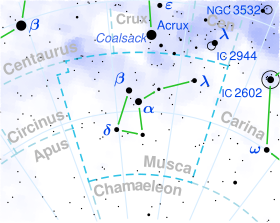 Global Information
Global InformationTheta Muscae information
 | |
| Observation data Epoch J2000 Equinox J2000 | |
|---|---|
| Constellation | Musca |
| Right ascension | 13h 08m 07.15286s[1] |
| Declination | −65° 18′ 21.6819″[1] |
| Apparent magnitude (V) | 5.53[2] (5.662 + 7.555[3]) |
| Characteristics | |
| θ Mus A | |
| Spectral type | WC5/6 + O6/7V + O9.5/B0Iab[4] |
| U−B color index | −0.91[5] |
| B−V color index | −0.43[3] |
| Variable type | Eclipsing + WR[6] |
| B | |
| Spectral type | O9III[7] |
| U−B color index | −0.90[5] |
| B−V color index | −0.055[3] |
| Astrometry | |
| Radial velocity (Rv) | −28.4[8] km/s |
| Proper motion (μ) | RA: −2.10[1] mas/yr Dec.: −11.52[1] mas/yr |
| Parallax (π) | 0.26 ± 0.48 mas[1] |
| Distance | 7,400[4] ly (2,270[4] pc) |
| Absolute magnitude (MV) | −6.2[9] |
| Orbit[10] | |
| Period (P) | 19.1375 d |
| Eccentricity (e) | 0.00 (assumed) |
| Inclination (i) | 49±6° |
| Semi-amplitude (K1) (primary) | 221±6 km/s |
| Details | |
| WR | |
| Mass | <11.5[11] M☉ |
| Luminosity | 234,000[11] L☉ |
| O | |
| Mass | 44[10] M☉ |
| Luminosity | 295,000[12] L☉ |
| Other designations | |
Theta Muscae, CD−64°699, HR 4952, HD 113904, HIP 64094, GSC 08997-02337, SAO 252162, PPM 359890, GC 17788, UCAC3 50-186265, IRAS 15465+2818, WR 48 | |
| Database references | |
| SIMBAD | data |
Theta Muscae (θ Muscae) is a multiple star system in the southern constellation Musca ("the Fly"), containing a Wolf-Rayet star and two massive companions. With an apparent magnitude of 5.5, it is the second-brightest Wolf–Rayet star in the sky,[13] although much of the visual brightness comes from the massive companions and it is not one of the closest of its type.
- ^ a b c d e Van Leeuwen, F. (2007). "Validation of the new Hipparcos reduction". Astronomy and Astrophysics. 474 (2): 653–664. arXiv:0708.1752. Bibcode:2007A&A...474..653V. doi:10.1051/0004-6361:20078357. S2CID 18759600.
- ^ Ducati, J. R. (2002). "VizieR Online Data Catalog: Catalogue of Stellar Photometry in Johnson's 11-color system". CDS/ADC Collection of Electronic Catalogues. 2237: 0. Bibcode:2002yCat.2237....0D.
- ^ a b c Høg, E.; Fabricius, C.; Makarov, V. V.; Urban, S.; Corbin, T.; Wycoff, G.; Bastian, U.; Schwekendiek, P.; Wicenec, A. (2000). "The Tycho-2 catalogue of the 2.5 million brightest stars". Astronomy and Astrophysics. 355: L27. Bibcode:2000A&A...355L..27H. doi:10.1888/0333750888/2862.
- ^ a b c Cite error: The named reference
sugawara08was invoked but never defined (see the help page). - ^ a b Moffat, A. F. J.; Seggewiss, W. (1977). "The Wolf-Rayet binary theta Muscae". Astronomy and Astrophysics. 54: 607. Bibcode:1977A&A....54..607M.
- ^ Samus, N. N.; Durlevich, O. V.; et al. (2009). "VizieR Online Data Catalog: General Catalogue of Variable Stars (Samus+ 2007-2013)". VizieR On-line Data Catalog: B/GCVS. Originally Published in: 2009yCat....102025S. 1. Bibcode:2009yCat....102025S.
- ^ Sota, A.; Maíz Apellániz, J.; Morrell, N. I.; Barbá, R. H.; Walborn, N. R.; Gamen, R. C.; Arias, J. I.; Alfaro, E. J. (2014). "The Galactic O-Star Spectroscopic Survey (GOSSS). II. Bright Southern Stars". The Astrophysical Journal Supplement. 211 (1): 10. arXiv:1312.6222. Bibcode:2014ApJS..211...10S. doi:10.1088/0067-0049/211/1/10. S2CID 118847528.
- ^ Wilson, Ralph Elmer (1953), "General Catalogue of Stellar Radial Velocities", Washington, Washington: Carnegie Institution of Washington, Bibcode:1953GCRV..C......0W.
- ^ Hidayat, Bambang; Admiranto, A. Gunawan; Van Der Hucht, Karel A. (1984). "Wolf-Rayet binaries: Evolutionary causes for their distribution in the Galaxy". Astrophysics and Space Science. 99 (1–2): 175–190. Bibcode:1984Ap&SS..99..175H. doi:10.1007/BF00650243. ISSN 0004-640X. S2CID 189850123.
- ^ a b Hill, G. M.; Moffat, A. F. J.; St-Louis, N. (1 October 2002). "Modelling the colliding-winds spectra of the 19-d WR + OB binary in the massive triple system Muscae". Monthly Notices of the Royal Astronomical Society. 335 (4): 1069–1078. Bibcode:2002MNRAS.335.1069H. doi:10.1046/j.1365-8711.2002.05694.x. ISSN 0035-8711. S2CID 121923927.
- ^ a b Nugis, T.; Lamers, H. J. G. L. M. (2000). "Mass-loss rates of Wolf-Rayet stars as a function of stellar parameters". Astronomy and Astrophysics. 360: 227. Bibcode:2000A&A...360..227N.
- ^ Sugawara, Y.; Tsuboi, Y.; Maeda, Y. (October 2008). "Redshifted emission lines and radiative recombination continuum from the Wolf-Rayet binary θ Muscae: evidence for a triplet system?". Astronomy & Astrophysics. 490 (1): 259–264. arXiv:0810.1208. Bibcode:2008A&A...490..259S. doi:10.1051/0004-6361:20079302. ISSN 0004-6361. S2CID 118447784.
- ^ C. de Loore; A.J. Willis (6 December 2012). Wolf-Rayet Stars: Observations, Physics, Evolution. Springer Science & Business Media. pp. 310–. ISBN 9789400979109.